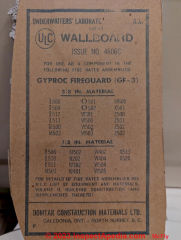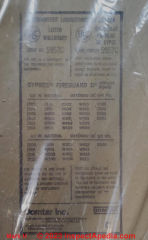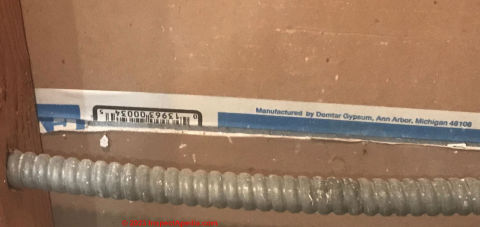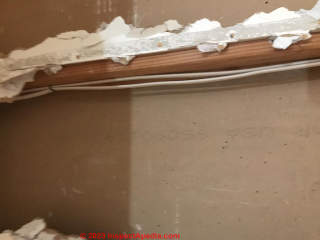 Asbestos Content in Canadian Domtar Gypsum Board
Asbestos Content in Canadian Domtar Gypsum Board
Does Domtar Gyproc contain asbestos? Where are Domtar products made?
- POST a QUESTION or COMMENT about the level of asbestos found in drywall on walls & ceilings.
Does Canadian Domtar brand drywall or Gyproc contain asbestos?
This article series explains where asbestos is likely to be found in gypsum board or drywall systems, particularly in the taping compound and in skim coats using drywall "mud" that contained asbestos.
InspectAPedia tolerates no conflicts of interest. We have no relationship with advertisers, products, or services discussed at this website.
- Daniel Friedman, Publisher/Editor/Author - See WHO ARE WE?
Canada Domtar Corporation Gyproc Drywall Asbestos - Gyproc
 Some drywall systems that may contain asbestos - at least in finishes, taping joint compounds, skim coats, or in systems that applied plaster over gypsum board date from about 1910 through the early 1980's in North America (1982 in Canada).
Some drywall systems that may contain asbestos - at least in finishes, taping joint compounds, skim coats, or in systems that applied plaster over gypsum board date from about 1910 through the early 1980's in North America (1982 in Canada).
In Canada most provinces classify the asbestos hazard associated with drywall removal as a "low risk or type 1" hazard requiring normal dust control. (Pinchin 2011).
Shown here: Domtar identifying stamps and markings.
[Click to enlarge any image]
Domtar Corporation, headquartered in Montreal, Canada, is the largest integrated producer of uncoated free-sheet paper in North America and the second largest in the world based on production.
Contact Domtar Canada: Domtar Corporation, 395 de Maisonneuve Blvd West
Montreal (Québec) H3A 1L6
Canada
1-514-848-5555
Email: communications@domtar.com or domtarcommunications@domtar.com Website: https://www.domtar.com/en
Contact Domtar U.S.: Domtar Corporation US: 234 Kingsley Park Drive
Fort Mill SC 29715
United States
1-803-802-7500
1-877-877-4685
Domtar Corporation Manufacturing Locations
This Domtar web page lists over twenty Domtar locations across North America: domtar.com/our-company/all-locations/
Among these, the company's website currently names seven manufacturing locations, not all of which make the same products, including the following (in 2023)
- Johnsonburg Mill, 100 Center St. Johnsonburg, PA 15845 USA 814.965.2521
- Kingsport Mill, 100 Clinchfield St. Kingsport, TN 37660 USA 423.247.7111
- Marlboro Mill, 585 Willamette Road Bennettsville, SC 29512 USA 843.479.0200
- Nekoosa Mill, 301 Point Basse Ave. Nekoosa, WI 54457 USA 715.886.7111
- Plymouth Mill, Highway 149 Plymouth, NC 27962 USA 252.793.8111
- Rothschild Mill, 200 N Grand Ave. Rothschild, WI 54474 USA 715.359.3101
- Windsor Mill, 609 Rang 12 P.O. Box 1010 Windsor, QC J1S 2L9 CANADA 1.800.263.8366
- There are nine additional manufacturing and converting facilities across the U.S. and ten regional replenishment centers.
Domtar Drywall Identification Stamps, Markings, Production Codes
Here is an excerpt from a Domtar product advertisement
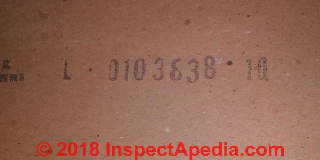 GYPROC
SHEATHING
IS
STRONG Comparative tests of Gyproc Sheathing
and horizontally applied wood sheathing
show that Gyproc Sheathing offers approximately 16 times greater resistance to
distortion in a wood frame structure.
GYPROC
SHEATHING
IS
STRONG Comparative tests of Gyproc Sheathing
and horizontally applied wood sheathing
show that Gyproc Sheathing offers approximately 16 times greater resistance to
distortion in a wood frame structure.
SAFE Gyproc Sheathing is made from Gypsum Rock. It will not burn nor carry fire. As it cannot transmit destructive temperatures it affords effective fire protection for wood framework.
PERMANENT Does not shrink, swell nor warp.
ECONOMICAL
Saves material- practically no waste.
Saves labour-easy to handle, cut and fit.
- JOURNAL, Royal Architectural Institute of Canada, Vol. 18 No. 6, Toronto, June 1941, [PDF] p. 2, retrieved k2019/01/04, original source: http://sextondigital.library.dal.ca/RAIC/PDFs/Volume18/vol18_no06_OCR_600dpi_PDFA1b_compressed.pdf
The 1941 product description of GLA's GYPROC gypsumboard makes no mention of asbestos.
GLA, Gypsum Lime and Alabastine Canada Limited also produced a Plasterer's Handbook in 1959, ASIN: B01MQ3WCA7 - but we have not been able to obtain a copy.
Also see DOMTAR CEILING TILES where we discuss the use or non-use of asbestos in some Domtar products.
Domtar Gyproc, Canadian Production Drywall Identification
Here we review Domtar identification stamps on wallboard and discuss the possible use of asbestos in some Domtar wallboard products.
Other questions about the use of asbestos in Domtar products focus primarily on those using vermiculite.
Below: edge tape from a section of Domtar drywall manufactured in Ann Arbor, MI, courtesy of InspectApedia reader Sho.
Below, an older drywall stamp for Domtar fire rated material.
Above: identifying stamp on Domtar's Gyproc FIREGUARD GYPSUM BOARD UL Classified R8742 Wallboard Type S, Issue No. C-3189, 5/8", by Domtar Gypsum
Below: a Gyproc product stamp on the back of drywall submitted by an InspectApedia reader cited in the reader Q&A .
This Gyproc stamp cites a Canadian standard CAN/CSA-A82.27 and provides what looks like a production code L 307848 -13 that can be helpful in estimating the age and possibly production date of this Gyproc drywall.
...
Reader Comments, Questions & Answers About The Article Above
Below you will find questions and answers previously posted on this page at its page bottom reader comment box.
Reader Q&A - also see RECOMMENDED ARTICLES & FAQs
On 2023-10-19 by InspectApedia DF (mod) - find & fix persistent source of elevated Carbon Monoxide in a building
@McFly,
Thank you for a helpful Canadian drywall asbestos question. Here at InspectApedia we've collected what information our research could find for each drywall manufacturer, including Domtar (this page).
The database of known drywall that contains asbestos is a good idea, but not one we've found actually reliable, so instead we maintain a series of articles on identifying drywall and discussing its asbestos risk for each drywall brand.
In our OPINION several problems prevent any such database from being reliable including the following:
- very often people cannot identify the specific drywall brand
- very often even when the drywall or gypsum board or "sheetrock" brand is evident, its year of manufacture may be hard, sometimes impossible, to determine. (We get some help from surrounding context such as the building's age and renovation history)
- Even if we know that a specific brand and individual drywall product is said by the manufacturer to have never contained any asbestos, depending on the age of the drywall AND the age of any work or repairs done on it, we can not rule out that asbestos-containing joint compound was used on that installation.
And in fact most often the greater asbestos risk is in the joint compound, not the drwyall.
So a drywall "asbestos test" is unreliable unless multiple samples are tested to make certain that not just the drywall but any and all generations of joint compound on the wall are also captured.
At the top of this page we note:
Some drywall systems that may contain asbestos - at least in finishes, taping joint compounds, skim coats, or in systems that applied plaster over gypsum board date from about 1910 through the early 1980's in North America (1982 in Canada).
In Canada most provinces classify the asbestos hazard associated with drywall removal as a "low risk or type 1" hazard requiring normal dust control.
From that, bottom line: normal dust control for working on Canadian drywall is probably sufficient.
So, thanks again for the photo and question; let me know what you think and what questions remain.
On 2023-10-19 by McFly - database on known sheetrock/drywall that contains asbestos?
I've been trying to navigate the site.
Is there a database on known sheetrock/drywall that contains asbestos?
I live in a building in Vancouver that had it's permit approved June 1977.
I haven't found a reputable lab to do the test yet. Attached is a photo of a sample stamp from the drywall that I removed. Any help is appreciated.
Btw, it is 5/8” thick. Building permit approval stamped June 1977, Vancouver.
On 2021-12-27 by Inspectapedia Com Moderator (mod) - Domtar Gyprock Fireguard information
@Mark H,
Domtar Gyprock Fireguard is a fire-rated drywall product. Please read the article above where you will find comments on asbestos in this product and a link to authoritative information such as a downloadable PDF copy of a U.S. DEHS study on asbestos hazards, full title Health Consultation
DOMTAR GYPSUM AMERICAN, INC. - 801 MINAKER DRIVE - ANTIOCH, CONTRA COSTA COUNTY, CALIFORNIA - EPA Facility ID CAD089182810 -
MAY 7, 2008
With the full list of Gyproc patent numbers in your photo, if we can make them out, we can research on the specific patents or you could try that as well to see if those mentioned in the use of asbestos. It's certainly a real possibility but you wouldn't assume that all fire rated drywall or gypsum board contains asbestos. It depends on the manufacturer, product, and year of production.
Or you could cut away the plastic so that you could post a sharper photo of this Domtar drywall stamp so that we can then get all of the necesssary data for further research.
Please tell us the age of this drywall product in your house or building, and in what country and city was it installed?
On 2021-12-27 by Mark H - Asbestos in Domtar Gyprock Fireguard?
Any thoughts on this. I can't get any info. Abestos check
On 2023-09-02 by InspectApedia Publisher (mod) - Where is Domtar Drywall manufactured?
@Sho,
As we mention in the Domtar article above on this page, we do not have an age decoder for Domtar.
Also in that article, we list several contextual clues that may help you more closely determine its age.
Beyond that, we are not able to give more definitive age data.
You ask for information about "where this is from" - by which we take you to mean you are asking where that drywall was manufactured.
The edge tape on the drywall in your photo answers your "where it is from " question as it contains this text:
Manufactured by Domtar Gypsum, Ann Arbor, Michigan 48108
You noted that in your original post and question, so I'm confused about your "where was it made" question - straighten me out if I've misunderstood.
there is also the remnant of a product bar code that you could look-up though IMO that's not really necessary. Below the bar code is 13963 00034
DOMTAR drywall was made in more than one manufacturing plant in Canada and in the U.S. - that information is found on the page that we asked you to check - read that information above - onb this page.
Thanks for the photo and discussion.
On 2023-09-01 by Sho - , couldn't find any info on when this [drywall or gypsum board] is from
@InspectApedia-911, I read it, couldn't find any info on when this is from :/ do you see anything that could help on the pictures?
On 2023-08-31 by InspectApedia-911 (mod)
@Sho,
Thank you those photos are helpful. As this is
Domtar drywall, you will want to read our article
ASBESTOS IN DOMTAR DRYWALL above on this page
On 2023-08-30 y Sho - drywall with a blue edge saying Manufactured to meet ASTM standard C-36 Manufactured by Domtar Gypsum
@InspectApedia DF,
On 2023-08-30 y InspectApedia DF (mod)
@Sho,
Could you post a photo or two showing a clear view of that marking on the blue edge as well as the surface of the drywall?
You can only post one photo per comment but can post as many comments as you wish.
On 2023-08-3 by Sho
Hello I found a piece of drywall with a blue edge saying Manufactured to meet ASTM standard C-36
Manufactured by Domtar Gypsum, Ann Arbor, Michigan 48108
Then a big stamp with : DOMTAR USA 95 08 22 16 44 J
On 2023-07-25 by InspectApedia Publisher (mod) - determine age of this Gyproc drywall
@The Seeker,
Your drywall / gypsum board is a Canadian Domtar Gyproc product.
The partially-visible coding L30078.48 ... plus the 13 that you added is probably part of a production date stamp used by Domtar for which we have not yet found an age decoder.
Stamped on your drywall is
MANUFACTURED TO MEET CSA A82.27M
That standard, properly-named is
- CSA CAN/CSA-A82.27-M91 Gypsum Board - the M91 edition, the second edition, and the newest we found, was published in 1991
- source: csagroup.org/store/product/2703219/
This is the second edition of CSA Standard CAN/CSA-A82.27-M91, Gypsum Board, written in SI (metric) units. It is one of the CSA Series of Standards on Gypsum and replaces the first edition of A82.2 7-M1977.
The first edition version was published in 1977:
- CSA A82.27-M1977 Gypsum Board Products, CSA, Canadian Standards Association, Web: csagroup.org/store/product/A82.27-M1977/
Excerpts:
Preface
This is the first edition of CSA Standard A82.27-MI977, Gypsum Board Products, written in SI le Système international d'unités). It is one of the CSA Series of Standards on Gypsum and Lime.
A82.27-M1977 now covers all types of gypsum board and it includes the requirements previously contained in CSA Standards A82.24-1962, Gypsum Lath; A82.27-1972, Gypsum Wallboard; A82.28-1962, Gypsum Sheathing Board; and A82.35-1966, Gypsum Backing Board and Coreboard. It therefore supersedes A82.24-1962, A82.27-1972, A82.28-1962, and A82.35-1966.
In addition, sections have been added to clarify terminology and types of gypsum board products and additional performance properties have been included for. core, end and edge hardness, nailhead pull resistance, and humidified deflection.
The Appendices Include tables to assist the user in converting metric measurements to the yard/pound system so that In effect the Standard may be readily used with both systems of measurement.This Standard was prepared by the Technical Committee on Gypsum and Lime under the jurisdiction of the Standards Steering Committee on Building Materials and Products and was formally approved by these Committees.
Scope
This Standard covers requirements for gypsum board designed for use with or without the addition of plaster, for walls, ceilings, and partitions.
Since the stamp on your Domtar Gyproc drywall doesn't include the edition year but does include the standard name itself, it's reasonable to guess that it was manufactured some time after 1977.
To obtain an exact date you might try contacting the manufacturer AND providing them with the complete production stamp data, only some of which is visible in your photo.
That contact information will be in the link we'll provide below.
When faced with the "how old is it" question for building materials, and when there is not a clear date stamp or code, I look for external clues of the age of the material, in this case the age of your Gyproc including
- Age of the building - that sets a floor under the probable age of its materials of construction
- Age of surrounding materials, particularly those that are likely to have been put in place at the same time
- Dates of renovation work, modifications, repairs to the building that involved drywall (look also at the wood framing behind the drywall for presence or absence of old fasteners or holes that can tell you if the drywall in your photo is original to that constrution
- Location of the building: country and city where this buiding is found
See details and Domtar contact information above on this page.
On 2023-07-23 by The Seeker
Looking for information on the stamps in the photos. Need manufacturing Month/Date/Year. It Also has two more digits which got cut out in the photo hence I am typing it. L3007848 13.
[Photo above]
This Q&A were posted originally at our website home page INSPECTAPEDIA.COM
On 2020-03-31 - by (mod) - Detailed data stamp on Domtar gypsum board or drywall
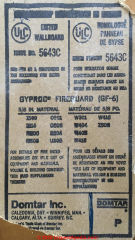 Duane
Duane
please take a look at DOMTAR GYPROC ASBESTOS?
and don't hesitate to ask follow-up questions
On 2020-03-31 by Duane Dubyk
Trying to determine if old drywall contains asbestos. Part number on one sample is C060983-17
[Click to enlarge any image]
This Q&A were posted originally
at DRYWALL TYPE IDENTIFICATION STAMPS
Question: does Domtar wallboard contain asbestos?
2020/01/03 Tyler Garneau said:
Domtar 92050600:0246 Rippon
Wall board type 9
Issue number c-3189
Wondering the age and if contains Asbestos
HERE is Tyler's original PHOTO of Domtar Gyproc FIREGUARD GYPSUM BOARD [image]
Reply: Gyproc Domtar FIREGUARD GYPSUM BOARD Type 9 Wallboard
As this is Domtar Fireguard it may contain asbestos.
Also see this HEALTH CONSULTATION, DOMTAR GYPSUM American, Inc., 801 Minaker Drive Antioch, Contra Costa County, California Epa Facility Id Cad089182810 May 7, 2008, [PDF] U.S. Department Of Health And Human Services, Public Health Service, Agency For Toxic Substances And Disease Registry, Division Of Health Assessment And Consultation, Atlanta, Georgia 30333 Contact ATSDR 1-800-CDC-INFO http://www.atsdr.cdc.gov
On 2020-01-30 - by (mod) -
Please try again to include your photo, you can include one photo / 1 comment by using the add image button
On 2020-01-30 by Louis W Heaton - Domtar Drywall in Seattle
Hello
I am working with a firm in the Seattle area - JRP Engineering, Inc. We have encountered exterior gypsum wall sheathing in a multi-family wood frame building in our area that we would like to establish whether the gypsum sheathing as originally manufactured, spec'd and installed was intended and certified for exterior applied building sheathing - under wood siding. The year the building was built was 1983.
Only partial investigation results are available. The stamps that we have encountered read:
DOMTAR GYPSUM AMERICA INC WATER REPELLENT" on the interior side of a wood framed metal chimney enclosure; and "1/2" IMPREGNATED SHEATHING " on the exterior side.
A print of photographs is included. with this inquiry.
On 2019-07-06 by (mod) - asbestos in Domtar GYPROC is 204v2a ?
Unfortunately because some of that company's drywall that contain asbestos and because there's no one left for us to ask or stuck with having to tell you three are treated as presumed to contain asbestos or have a sample tested.
Testing cost less than $50.
If you decide to test you sure you test with joint compound as well as the gypsum-board itself. Be sure to let me know what you find is that will help other readers.
See details at ASBESTOS in CANADIAN DOMTAR GYPROC DRYWALL?
To test your dyrwall and joint compound see ASBESTOS TESTING LAB LIST
On 2019-07-05 by Barbara Main
The house we are renovating was built in 1972. The code on the Domtar GYPROC is 204v2a
Are you able to determine if it has asbestos?
On 2018-09-24 by (mod) - trying to decode the stamps on Canadian Gyproc or Blue Domtar Logo Gypsum Board
IMO it seems likely that the company would have known what their number-stamps meant; but if a company is no longer around it can be difficult to find that documentation unless you find it in a legal proceeding, litigation, or on occasion, a patent disclosure.
On 2018-09-19 by Ivan Garcia
Do you think there's a chance that decoder could be out there?
I haven't been able to find one.
On 2018-09-11 by Ivan Garcia - Canadian-made Gyproc with Blue Domtar logo
 Here is a picture of the production code number. Do you think a decoder could be found for it?
Here is a picture of the production code number. Do you think a decoder could be found for it?
Regards.
Ps, I found that on some of these sheets, there is a blue Domtar logo on the edge.
Thanks again.
Ivan
On 2018-09-08 by (mod) - photo of Canadian-made Gyproc gypsum board
I look forward to the photos; thanks for asking.
On 2018-09-05 by Ivan Garcia
Wow-
Thanks for the prompt and thorough reply. Great info.
Country is Canada- province Manitoba, city Winnipeg.
I will get a better shot of the number stamped at the right end of the photo. Thank you for looking into an age decoder for Gyproc Stamps.
Regards,
Ivan
On 2018-09-05 by (mod) - identify this Gyproc made in Canada
Thank you for an interesting and useful question, Ivan.
It might be that the number, partly visible in the right end of your photo as it appears, is a production run number that in turn might be able to be decoded to a date, but I have not yet found an age decoder for Gyproc stamps and I'm doubtful.
When faced with the "how old is it" question for building materials, and when there is not a clear date stamp or code, I look for external clues of the age of the material, in this case the age of your Gyproc including
Age of the building - that sets a floor under the probable age of its materials of construction
Age of surrounding materials, particularly those that are likely to have been put in place at the same time
Dates of renovation work, modifications, repairs: in your case mid 80s then mid 90s, then mid 2000s.
Location of the building: country and city, since when addressing your asbestos question we know, for many countries, about when asbestos use in drywall and drywall mud (joint compound) ceased.
In your photo the fabric-covered electrical wire is likely from original construction. The wooden stud looks newer than 1949 as it is so light in color, but I see what looks like paint or something in the lower right corner of the photo that may be older material.
If the Gyproc in your photo was part of the basement renovation work then you have an "oldest" date of 1985. For North America that's likely to be post-asbestos.
On 2018-09-05 by Ivan Garcia
1949 home. Concerned this drywall and/or mud May have asbestos. Previous owners said they did 3 rennos on the basement- in the mid 80s then mid 90s, then mid 2000s. Can the age of this drywall be identified by the printing on it?
On 2017-08-19 by (mod) - It would be unusual for a 1987 Canadian home to use friable asbestos in its materials,
Oon
It would be unusual for a 1987 Canadian home to use friable asbestos in its materials, since Canada outlawed the production of most asbestos-containing materials back in 1979. However a builder could have used "new old stock" of some asbestos-containing materials so no one can, by e-text, bet their puny life savings nor your concern on a mere e-text.
"Testing" in your daughter's room sounds iffy to me. Test what? Air? There is so much variability in such tests that a negative result wouldn't be enough. Testing settled dust? Maybe if you had a representative dust sample.
Testing remaining original materials, probably could be done if handled properly. "Inspect" for asbestos? Not very useful as by eye no one can say for sure if there is asbestos in drywall or joint compound.
More often asbestos hazards in drywall are more significant in the joint compound used to tape joints not in the drywall body. But you're right about the limited usefulness of looking at drywall photos - it all looks the same.
Canada has strict controls on asbestos (Canada's Hazardous Products Act 1985) but not comprehensive ones. Non-friable asbestos containing materials such as cementious items might still be produced, and Canada continues to export products containing chrysotile asbestos.
You could have a representative dust sample tested - see ASBESTOS TESTING LAB LISThttps://inspectapedia.com/hazmat/Asbestos_Test_Lab_Lists.php for labs and procedures.
You could do appropriate cleanup - damp wiping and HEPA vacuuming.
Or you could hire an expert - if it's a real one - to collect samples from walls and ceilings.
If it were my home, in my OPINION, I'd focus on proper cleanup of any remaining dust. The un-disturbed wall or ceiling drywall now finished and patinted, isn't going to be releasing dust from its components.
On 2017-08-19 by Oonagh
Hi there,
So sorry to bother you, but very worried about something. I am renting a townhouse built in 1987 in Vancouver BC. I assumed something built so recently wouldn't have asbestos in it, but now am worried. There was a roof leak over my daughter's room and a restoration company had to come and cut through the ceiling in her room to see if there was mold, etc, as a result of the leak.
It didn't even occur to me that there could be asbestos in the ceiling above her room and the restoration company only took basic precautions regarding the spread of dust in our home as a result of the repair, and there was no testing for asbestos before it was done.
I know I need to have a company come in and test her room, but I literally can't sleep at night worrying about it and our possible exposure until such a time as it is done.
Would a new townhouse build in 1987 in Vancouver BC be likely to have asbestos in the ceiling or drywall? I have studied your photographs and they do not seem similar, but who knows?
Thank you ever so kindly,
Oonagh
On 2017-02-04 01:20: by Allan F
@Andy Clark,Did you ever find out? I have the same drywall, house built in 1974 (Ontario, Canada). Already remodelled a couple rooms and took it all down...
On 2017-01-04 by (mod) re: recommend asbestos tes labs to determine if older drywall or joint compound contains hazardous levels of asbestos
Sure Andy,
Search InspectApedia.com for ASBESTOS TEST LABS to find a certified lab or a list of them; send a small sample - cost is about $50.
Keep in mind that more common was asbestos in joint compound.
On 2017-01-04 by Andy Clark
My drywall is Branded Gyprock, Fire protection. House constructed in 1972. Is it possible to determine if there is an asbestos risk if disturbed?On 2018-11-11 by (mod) - Westroc Western Gypsum Limited Asbestos Content?
Christine,
Since the principal source of asbestos in drywall is most often in the joint compound.
And if the drywall in your home was demolished in a way that made a Dusty mess including of the tape to drywall joints, then at this point if you want to know if you need further special clean up you might want to Simply collect a tape sample of settled dust and have that analyzed by an asbestos test lab.
Let me know what you find and I can offer further advice.
See the advice given at ASBESTOS-SUSPECT DRYWALL ENCAPSULATE in PLACE
Also see ASBESTOS HAZARDS in CANADIAN DRYWALL - RESEARCH
On 2018-11-11 by Christine
My dad just tore down a wall in our house, and I'm concerned about whether or not there is now airborne asbestos in our house.
The company is Westroc Western Gypsum Limited (Canadian company), and our house was built in 1968. I have tried researching to find out for myself, but can't seem to find any information pretaining to this company's use of asbestos (or lack thereof).
...
Continue reading at ASBESTOS-DRYWALL REMEDIATION / REMOVAL or select a topic from the closely-related articles below, or see the complete ARTICLE INDEX.
Or see these
Recommended Articles
- ASBESTOS CEMENT CEILING & WALL PANELS
- ASBESTOS HAZARDS in CANADIAN DRYWALL - RESEARCH
- ASBESTOS in CANADIAN DRYWALL - including Domtar
- ASBESTOS in DRYWALL - home
- ASBESTOS-DRYWALL REMEDIATION / REMOVAL
- ASBESTOS IDENTIFICATION IN BUILDINGS
- ASBESTOS LIST of PRODUCTS
- ASBESTOS in PLASTER - what about the use of asbestos in plaster walls & ceilings?
- ASBESTOS PRODUCING COMPANIES & TRUSTS - complete list includes all asbestos-containing drywall producing companies
- CANADA ASBESTOS REGULATIONS
- DRYWALL & GYPSUM BOARD COMPOSITION & HISTORY - home
- HAZARD vs RISK - what's the difference?
Suggested citation for this web page
ASBESTOS in CANADIAN DRYWALL at InspectApedia.com - online encyclopedia of building & environmental inspection, testing, diagnosis, repair, & problem prevention advice.
Or see this
INDEX to RELATED ARTICLES: ARTICLE INDEX to ASBESTOS HAZARDS
Or use the SEARCH BOX found below to Ask a Question or Search InspectApedia
Ask a Question or Search InspectApedia
Try the search box just below, or if you prefer, post a question or comment in the Comments box below and we will respond promptly.
Search the InspectApedia website
Note: appearance of your Comment below may be delayed: if your comment contains an image, photograph, web link, or text that looks to the software as if it might be a web link, your posting will appear after it has been approved by a moderator. Apologies for the delay.
Only one image can be added per comment but you can post as many comments, and therefore images, as you like.
You will not receive a notification when a response to your question has been posted.
Please bookmark this page to make it easy for you to check back for our response.
IF above you see "Comment Form is loading comments..." then COMMENT BOX - countable.ca / bawkbox.com IS NOT WORKING.
In any case you are welcome to send an email directly to us at InspectApedia.com at editor@inspectApedia.com
We'll reply to you directly. Please help us help you by noting, in your email, the URL of the InspectApedia page where you wanted to comment.
Citations & References
In addition to any citations in the article above, a full list is available on request.
- In addition to citations & references found in this article, see the research citations given at the end of the related articles found at our suggested
CONTINUE READING or RECOMMENDED ARTICLES.
- Carson, Dunlop & Associates Ltd., 120 Carlton Street Suite 407, Toronto ON M5A 4K2. Tel: (416) 964-9415 1-800-268-7070 Email: info@carsondunlop.com. Alan Carson is a past president of ASHI, the American Society of Home Inspectors.
Thanks to Alan Carson and Bob Dunlop, for permission for InspectAPedia to use text excerpts from The HOME REFERENCE BOOK - the Encyclopedia of Homes and to use illustrations from The ILLUSTRATED HOME .
Carson Dunlop Associates provides extensive home inspection education and report writing material. In gratitude we provide links to tsome Carson Dunlop Associates products and services.




